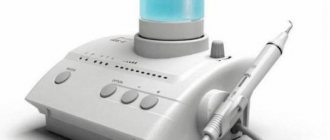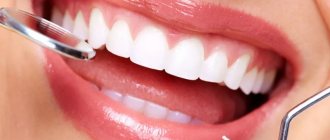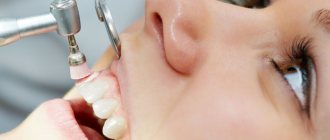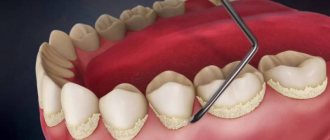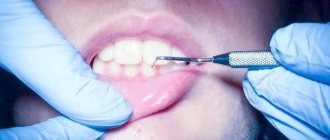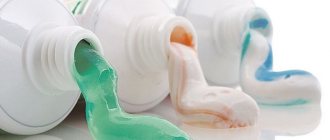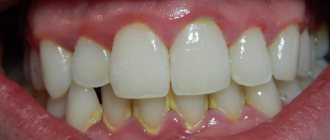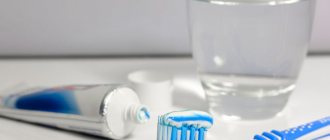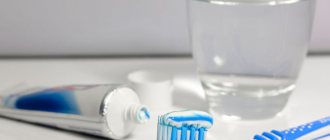Teeth cleaning with ultrasound is an innovative alternative to the classic procedure of mechanical removal of tartar.
Its advantage is minimal damage to tissues, thorough treatment of the oral cavity with better quality of teeth cleaning. Let's look at the new ultrasonic treatment technique in more detail, taking into account all its pros and cons, price and reviews.
Preparation for the procedure
First of all, the specialist examines the client and assesses whether the condition of his teeth and gums meets all the requirements and restrictions of this procedure.
The doctor must ask about any contraindications.
Attention! Since many of them are not detected during examination, pay close attention to the relevant section of the article.
Some clinics use a special safe solution, after applying which the tartar appears on the tooth enamel in a brighter shade. This method makes the specialist’s work easier.
What is dental plaque and how is it removed in dentistry?
Dental plaque is plaque that remains on the teeth after eating or drinking. This plaque contains large quantities of various bacteria and pathogenic microorganisms that harm the health of our teeth and gums. If soft dental deposits are not removed by regular brushing, they will gradually harden and turn into stone, which cannot be removed at home. Both hard and soft deposits on teeth increase the risks of developing caries, periodontitis and periodontal disease. Therefore, you need to deal with their timely removal.
Some people think that brushing their teeth every day will be enough to completely remove plaque, but this is not true. Even if you carry out dental hygiene according to all the rules and using all the recommended tools (brushes, brushes, floss), you will still not be able to carry out high-quality removal of deposits from hard-to-reach places in the oral cavity - interdental spaces, in the space above and below the gums. For this reason, to remove dental plaque, you need to go to dentistry and carry out the procedure using professional techniques and instruments.
To remove dental plaque in modern dentistry, various methods are used, and below we will consider in detail the most popular methods of cleaning teeth and the oral cavity from plaque and tartar.
Calculate the cost of treatment by taking a short test in 20 seconds!
Do not delay your treatment, because in this matter time plays against us.
Main stages of ultrasonic processing
With the exception of certain details, ultrasonic removal of tartar occurs according to the following method.
Brushing teeth with a skyler
The first stage is a rough cleaning of the teeth, which is done using a professional instrument - a scaler (scaler, scaler).
Its operating principle is based on the oscillatory movements of ultrasonic waves (up to 20 thousand hertz):
- Skyler destroys tartar and other deposits.
- The dirt is immediately washed away by the pressure of water with a medicinal composition. The dentist tilts the tip of the device, directing the stream along the surface being treated so that it does not destroy the enamel.
- Then the moisture is pumped out with a saliva ejector.
This completes the first stage. Depending on the number of teeth cleaned, it takes about 40 minutes.
The process of removing stones with a skyler
Polishing
After rough processing, more precise correction occurs using the polishing method. The purpose of this stage is to remove residual dirt, smooth the enamel and whiten the teeth.
There are two polishing techniques:
- Mechanical - using brushes and paste to treat the space between the teeth, as well as strips - strips with a solution of sodium carbonate, which are glued to the surface and after a while removed along with the remnants of foreign elements separated from the enamel;
- Hardware - by supplying a stream of water with an abrasive gel, while the Air Flow device polishes teeth better, but is ineffective for heavy deposits on the enamel that it cannot remove.
Polishing your teeth takes approximately 15 minutes.
Teeth polishing using the Air flow method
Mechanical teeth polishing
Fluoridation
At the fluoridation stage, at the request of the customer, a strengthening gel is rubbed into the enamel. Due to fluoride, it promotes the rapid restoration of weakened tooth surfaces in places with worn enamel and prevents infection.
Important! Typically, all 3 stages of the procedure are completed in one visit to the dentist. Their total duration is adjusted depending on the degree of neglect of tartar, but usually does not exceed one hour.
Fluoride teeth strengthening procedure
Diagnosis of dental deposits
Detecting plaque on teeth is a fairly simple matter. Even if you run your tongue over their surface, you can feel it if there is a coating. The surface of the teeth does not seem so smooth. You can see it in the mirror; such deposits are best visible on the lower jaw from the inside.
Smokers can see the plaque without any problems, since it most often has a brownish color. At the pharmacy you can buy special pastes or tablets that color the plaque a different color, but the most effective way is to visit a dentist, who will determine how much your oral hygiene can be assessed.
Actions after the procedure
After ultrasound therapy, a patient with an incorrect bite must be given a pause, during which he does not put on braces.
If after the session it is planned to continue dental treatment, the patient is given several days of rest to restore areas with thinned enamel.
Then the doctor begins filling or installing dentures.
After ultrasound therapy, a patient with a malocclusion must be given a pause, during which he does not put on braces. This is also required to restore the enamel.
Also after therapy, slight bleeding of the gums is possible. In this case, the dentist takes action to stop it.
Service cost
Offers for dental correction with ultrasound are provided in private dental clinics. It is not included in the mandatory list of free procedures.
The average cost of one course varies between 1500-3000 rubles. The difference in price is due to the marketing policy of dentistry and additional actions, for example, the need for anesthesia.
In addition to complete cleaning, you can order cleaning of one or more teeth. In this case, you will have to pay from 100 to 150 rubles to clean each one.
Advantages and disadvantages of ultrasound therapy
Thorough treatment of all root canals is the main advantage of ultrasonic teeth cleaning
The most important advantage of the service is the tangible cosmetic effect.
After the session, the patient is completely free of plaque in any part of the tooth surface. His teeth become brighter due to the whitening effect.
Unlike alternative methods of mechanical and chemical action, ultrasonic vibrations are not harmful to enamel and gums, and the procedure itself is quick and does not hurt.
Modern hardware ultrasound technologies have the following advantages:
- thorough treatment of all root canals;
- smoothing the relief surface of the enamel;
- correction of teeth shade in smokers;
- teeth whitening effect.
Unfortunately, the technique is not without a number of disadvantages:
- the presence of a large number of contraindications;
- the likelihood of mechanical injuries to dentin;
- high cost of treatment;
- Ultrasonic cleaning does not provide permanent results, so re-treatment may be required after one or two years.
The extent to which the benefits of ultrasound therapy outweigh its negative aspects depends on the professionalism of the dentist. Therefore, when making an appointment, pay attention to the reviews and qualifications of the doctor who will clean your teeth with ultrasound.
Chemical removal of tartar
If mechanical methods of removing deposits do not give the desired result or the case is particularly complex, then you will have to resort to the help of chemistry. If there is greater mobility of teeth or deposits are located in large clusters, then a gel is applied, which contains: alkalis, acids, iodine. It is capable of destroying plaque. The composition is applied for just one minute, and then removed, and the mouth is rinsed with water. If this method of combating dental plaque is used, the dentist must carefully protect the gums from the effects of the gel. Based on this, it can be argued that the root zone of the tooth remains poorly cleaned, so the method is considered insufficiently effective.
How harmful can a service be?
A procedure approved by the medical community cannot be harmful by definition.
However, the method of ultrasonic cleaning of enamel requires a careful assessment of the condition of the teeth before starting treatment.
If the doctor misses the presence of contraindications or violates the order of work, the use of the device may harm the client’s health:
- cause damage to the enamel when it is weakened;
- injure the gums and cause bleeding.
More serious damage can be caused to the patient's body if he does not notify the dentist about existing contraindications.
Attention! Persons with pacemakers should be especially vigilant. Ultrasonic vibrations can damage the device that helps the heart function.
It is clear that the consequences of such treatment are not just harmful, but pose a mortal danger.
What are the benefits of a therapeutic and cosmetic session?
The correction procedure has a multifaceted beneficial effect:
- Under the influence of an ultrasonic wave, hard foreign deposits are broken down over the entire surface, including the space under the gums. This result is not available using similar methods.
- Along with the cleansing effect, the enamel whitens, which acquires a natural shade - softer and more natural than after other corresponding procedures.
- After cleaning with the device, the doctor will be able to quickly identify pathologies of the tissues of the interdental space and gums.
- The procedure is painless and much faster than other methods.
- Cleaning helps during periodontal treatment and fillings. It is often recommended to remove deposits before prosthetics.
These are only the main results that can be achieved after completing the course of treatment. The beneficial qualities of the procedure are not limited to this.
Contraindications
Innovative teeth cleaning is not suitable for everyone.
The list of contraindications includes:
- Ultrasonic teeth cleaning is not suitable for everyone; there are contraindications
installed pacemakers;
- arrhythmia of the heart muscle;
- dental implants, including crowns (the doctor avoids them during cleaning);
- asthma;
- the presence of diseases of the digestive system;
- increased sensitivity of teeth;
- age under 18 years;
- Chronical bronchitis;
- tuberculosis;
- acute respiratory infections and acute respiratory viral infections in the acute or chronic stage;
- HIV;
- oncology;
- frequent bleeding in the mouth;
- allergy to components used during ultrasonic cleaning;
- liver damage, in particular all forms of hepatitis;
- pregnancy and breastfeeding period.
In addition to the listed factors, there are individual characteristics of the body, after studying which the dentist may refuse to perform the procedure. In this case, you should choose an alternative option for whitening or removing tartar.
When is it not recommended to brush your teeth?
This method of hygiene should be abandoned during pregnancy and breastfeeding, as well as in case of kidney disease and tuberculosis. The procedure should be carried out extremely carefully (or not at all) in cases of depleted and very thin tooth enamel, extensive caries lesions, viral diseases, immune pathologies, as well as in cases of diseases in the acute stage (for example, bronchitis, tonsillitis, etc.). Allergy to medications is also considered a contraindication for cleaning (for example, when performing Air Flow cleaning).
The most common questions
Does the procedure require pain relief?
Of course, this is the question that primarily concerns patients at the dental clinic. Unlike outdated mechanical cleaning technology, ultrasound does not cause discomfort, so the average client will not need pain relief.
Anesthesia, in its mildest forms, may only be required when treating the subgingival area and if the patient has sensitive teeth.
Is it possible to remove tartar if you have untreated caries?
Ultrasound cleaning can be done for caries. The presence of a carious cavity in a tooth does not affect the operation of the device in any way. An infectious disease is not a contraindication for ultrasonic cleaning. On the contrary, during complex dental treatment, dentists often begin work by removing stones and only then begin to treat caries.
Is the device capable of removing stones under the gum?
Subgingival tartar is a dangerous defect, the damage of which sometimes leads to periodontitis. Fortunately, Skyler can remove it. The device will not only thoroughly clean the treated area, but also carry out ultrasonic polishing of the root surface.
Ultrasonic tartar cleaning - before and after the procedure
Why do plaque and tartar form? 8 reasons worth knowing
The most common causes of stone and plaque formation are the following:
- Poor oral hygiene;
- Poor quality or incorrectly selected paste or brush;
- Abuse of carbohydrate foods (sweets, baked goods);
- Smoking;
- Frequent consumption of coffee, tea, coloring products;
- Diseases of the stomach and intestines;
- Dental malocclusion;
- Long-term use of medications (in particular antibiotics).
